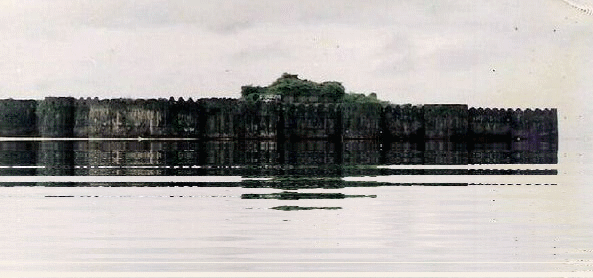 |
Built By The Siddis of Janjira, The Fort Has The Reputation Of Having Never Been Conquered By An Enemy In Its 350 Year History. The Great Maratha Leader Shivaji Attacked The Fort In 1659, But Could Not Scale The 15m High Walls. His Son Sambhaji Tried To Dig A Tunnel But A Natural Moat, 90ft Deep, Surrounding The Fort, The Warted His Attempts. The Local Guides Will Tell You That Everytime The Fort Walls Were Raised, They Would Crumble Down Mysteriously. On The Advise Of A Priest, The Siddi Chieftain Buried His Son Alive To Appease The Gods And Remove The Curse. Placed Strategically All Along The Fort Are 275 Cannons, The Largest Of Which Has A Range Of 3km And Is The Third Largest Cannon In Maharashtra. Right In The Middle Of The Fort Is A Fresh Water Tank Fed By An Underwater Spring.
|
|
|
|
Situated on a rock of oval shape near the port town of Murud, 165kms south of Mumbai, Janjira is one of the strongest marine forts of India (the word ‘Janjira’ is a corruption of the Arabic word Jazira for island). The forts is approached by sailboats from Rajapuri jetty. The main gate of the fort faces Rajapuri on the shore and can be seen only when one is quite close to it. It has a small postern gate towards the open sea for escape. The fort has 19 rounded bastions, still intact. There are many canons of native and European make rusting on the bastions. Now in ruins, the fort in its heyday had all necessary facilities, e.g., palaces, quarters for officers, mosque, a big fresh water tank, etc. On the outer wall flanking the main gate, there is a sculpture depicting a tiger-like beast clasping elephants in its claws. This sculpture, its meaning difficult to interpret, appears on many fort-gates of Maharashtra.
|
| Originally the fort was small wooden structure built by a Koli chief in the late 15th century. It was captured by Pir Khan, a general of Nizamshah of Ahmednagar. Later the fort was strengthened by Malik Ambar, the Abyssinian Siddi regent of Ahmednagar kings. From then onward Siddis became independent, owing allegiance to Adilshah and the Mughals as dictated by the times. Despite their repeated attempts, the Portuguese, the British and the Marathas failed to subdue the Siddi power. Shivaji’s all attempts to capture Janjira fort failed due to one reason or the other. When Sambhaji also failed, he built another island fort, known as Kansa or Padmadurg, just 9kms north of Janjira. The Janjira state came to an end after 1947. The palace of the Nawabs of Janjira at Murud is still in good shape. |
|
|
|













